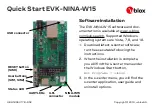
___________________________________________________________________________________________
EA321
5
4.6
Excitation (EXC) Adjustment
This adjustment is set and sealed in the works and
should not be tampered with. An over excitation
condition is indicated by the illumination of the red LED
which also indicates under-speed running and
over-volt.
The generator must be stopped to reset an
over-excitation trip.
4.7
DIP Adjustment
4.7.1 This feature is mostly used when the generator is
coupled to turbo charged engines with limited
block load acceptance. The feature works by
increasing the V/Hz slope to give greater voltage
roll off in proportion to speed.
4.7.2 With the DIP control fully anti-clockwise, the
generator voltage will follow the normal V/Hz line
as the speed falls below nominal. Turning the
DIP control clockwise provides greater voltage
roll off aiding engine recovery.
4.8
RMS Voltage Adjustment
When the generator is operating with a relatively low
power factor load, or other reasons change the output
power waveform when adding load, this will then cause
the AVR sensing the deviated voltage.
The RMS control on the AVR can reduce the voltage
variations caused by the output waveform changes. This
improves voltage regulation.
4.9
DWELL
This feature is mostly used when the generator is
coupled to turbo charged engines with limited block
load acceptance. The feature works by introducing a
delay between speed recovery and voltage recovery
and allows a greater DIP setting without instability.
With the DWELL control fully anti-clockwise, the
generator voltage will follow the V/Hz line. Turning the
DWELL control clockwise increase the delay time
between speed recovery and voltage recovery.
4.10 Current Limit (I LIMIT) Adjustment
This feature is mostly used to limit short circuit current or
to provide a current limit on motor starting. To use this
feature, current limit CT’s of the correct ratio need to be
connected to the AVR S1, S2 terminals. There is an
internal time limit of 10 seconds. Consult the factory
before using this feature.
4.11 Over Voltage (OVER V) Adjustment
This adjustment is set and sealed in the works and should
not be tampered with. An over voltage condition is
indicated by the illumination of the red LED which also
indicates under-speed running and over-excitation. The
generator must be stopped to reset an over-voltage trip.
4.12 RAMP
The AVR includes a soft start or voltage ramp-up circuit
to control the rate of voltage build up, when the
generator runs up to speed. This is normally pre-set
and sealed to give a voltage ramp-up time of
approximately 3 seconds. If required, this can be
adjusted between the limits defined in the specification.
WARNING
Please make sure you have read and understand
the contents of the instruction manual prior to
installation. Incorrect wiring connection may
result in irreversible damage to the product and
other equipments.
SECTION 5 : FITTING AND OPERATING (Refer to generator wiring diagram for connection
details)
ATTENTION
1. Leave sufficient space for the high output resistor to
dissipate heat. Install the AVR with an up right position
where the high output resistor is above heat sink.
2. AVR can be mounted directly on the engine,
genset, switchgear, control panel, or any position
that will not affects operation. For dimension
reference, please see Figure 1.
3. All voltage readings are to be taken with an
average-reading voltmeter Meggers and high-potential
test equipment must not be used. Use of such
equipment could damage the AVR.
4. Improper setting of under-frequency protection could
cause the output voltage of the unit to drop or become
unstable under with changes in load. Avoid making
any changes to the U/F setting unless necessary.
5. Set the O/E potemtiometer at max. position when
paralleling.
DWELL
UFRO
DIP
RMS
STABILITY
VOLTS
DROOP
TRIM
I/LIMIT
EXC. TRIP
OVER / V
INDICATOR
LED
RAMP
Resistor
Resistor
114.5
65.0
203.5
129.6
153.6
20.0
43.5
5.5
Figure 1
Outline Drawing
























